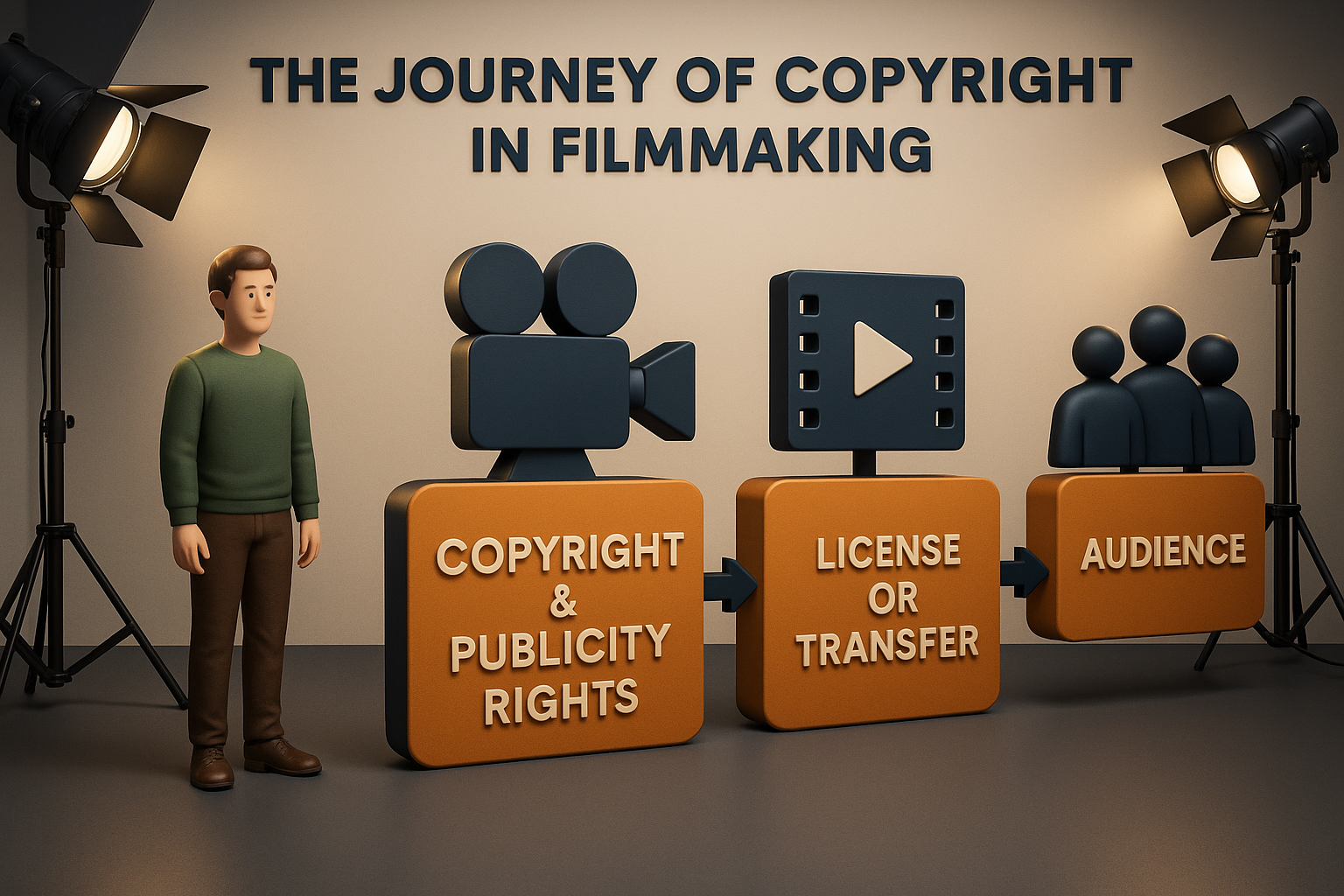The Journey of Copyright in Filmmaking

What Is a Film From a Legal Standpoint?
From a creative perspective, a film is art — a story told through motion, image, and sound.
From a legal standpoint, however, a film is an array of intellectual property rights carefully bound together into a single commercial product.
At its core, a film embodies two major legal components:
– Copyright — protecting the artistic and technical contributions such as screenplay, cinematography, direction, editing, and music.
– Right of Publicity — protecting the identity and likeness of performers, ensuring lawful use of their image, name, and voice.
A motion picture cannot be distributed or monetized unless both of these rights are properly secured, transferred, and cleared.
This is why filmmaking is not only creative collaboration — it is also a journey of copyright.
⚖️ The Legal Journey: From Script to Screen
Every finished motion picture represents a chain of legal ownership.
Copyright and related rights travel from creators to producers, and then to distributors and platforms, through a series of contracts.
This process ensures that each person or company has the authority they need to exploit the film commercially.
🖋️ 1. Copyright Begins With the Creator
Under the U.S. Copyright Act (17 U.S.C. § 201), ownership originates in the person who creates the work — the writer, composer, director, cinematographer, or editor.
Unless that ownership is explicitly transferred, the creator remains the legal author.
To allow production and distribution, these rights must travel from the individual to the production company.
This transfer often occurs under the “work made for hire” doctrine.
⚖️ 2. Understanding “Work Made for Hire”
The phrase work made for hire is widely used but narrowly defined.
It does not mean “I paid for it, so I own it.”
Under 17 U.S.C. § 101, a work qualifies as “made for hire” only under two conditions:
A. Employee Works
If a creator is an employee acting within the scope of employment — such as a full-time staff editor or in-house cinematographer — the employer automatically owns the copyright.
B. Specially Commissioned Works
If the creator is an independent contractor, the work can still be “made for hire” if:
– It falls into one of nine statutory categories (including motion pictures and other audiovisual works), and
– There is a written agreement signed by both parties explicitly stating the work is “made for hire.”
When both conditions are met, the production company becomes the legal author and copyright owner upon creation — even though the artist is not an employee.
This is how production companies lawfully consolidate creative contributions from multiple independent artists.
🧾 3. Dual Protection: Assignment + Work-for-Hire
Because courts interpret “work for hire” narrowly, most entertainment contracts include both a work-for-hire clause and a backup assignment clause, for example:
“All results and proceeds of your services shall be deemed a work made for hire.
To the extent any portion does not qualify as such, you hereby assign all rights, title, and interest to Producer.”
This double protection creates a clean chain of title — essential for E&O insurance and distributor acceptance.
🌟 4. Publicity and Performance Rights
A film cannot exist legally on copyright alone.
Actors, models, and performers hold rights of publicity, allowing them to control the commercial use of their likeness and identity.
Producers obtain these through appearance releases or performance agreements, authorizing the use of the actor’s image, voice, and name in the film and promotional materials.
In California and several other states, these rights survive death — up to 70 years post-mortem under Cal. Civ. Code § 3344.1.
Without such releases, a film cannot lawfully be marketed or distributed.
🎞️ 5. From the Production Company to the Distributor
Once the production company consolidates all copyrights and publicity rights, it becomes the central rights holder.
It can now enter into distribution and sales agreements that determine how and where the film reaches its audience.
A. Licensing Agreements
In most cases, distributors receive a license for:
– Territory – e.g., North America, Asia, or worldwide
– Media – theatrical, streaming, broadcast, DVD
– Term – usually 10–25 years
The producer retains ultimate ownership, and the rights revert after the license expires, allowing future re-licensing or platform sales.
B. “All Rights” and Perpetual Buyouts
In other cases, distributors purchase all rights in perpetuity — an “all rights acquisition.”
Here, the distributor becomes the permanent copyright owner, often including sequel, remake, and merchandising rights.
A typical clause reads:
“Producer hereby irrevocably sells, assigns, and transfers to Distributor all rights, title, and interest in and to the Picture, including copyright and all renewals thereof, throughout the universe, in perpetuity.”
This grants the distributor full control forever — powerful but irreversible.
Producers must weigh the immediate financial benefits against the permanent loss of ownership and residual revenue.
🌍 6. International Dimensions
Outside the United States, many jurisdictions protect moral rights that cannot be waived completely.
For instance, under French law, an author always retains the right to be credited and to object to derogatory treatment of their work.
Because of this, American work-for-hire contracts often require choice-of-law clauses and international adjustments to remain valid worldwide.
💡 7. The Legal Takeaway
A film is not a single piece of property — it’s a bundle of intellectual property rights carefully assembled through contracts.
Each right must be identified, documented, and transferred in a way that creates a clear chain of title.
Without that foundation, even a completed, award-winning film can be legally unsellable.
Understanding how copyright and publicity rights travel — from creator, to production company, to distributor — ensures that creativity becomes a secure, exploitable asset.
🎬 From script to screen, every frame carries a legal story.
Protecting that story is what transforms art into a sustainable business.
© Law Offices of Ernest Goodman – Entertainment & IP Law, Burbank, CA
As an an Entertainment snd IP attorney, my mission is to help creative professionals protect their rights, secure financing, and build sustainable careers in this rapidly
✍️ Written by Ernest Goodman, Entertainment & IP Lawyer.
⚠️ Disclaimer by Ernest Goodman, Esq.
This article is intended for informational purposes only and does not constitute legal advice. Reading or relying on this content does not establish an attorney-client relationship. Because laws differ by jurisdiction and continue to evolve in response to AI technologies, readers are encouraged to consult a qualified attorney licensed in the relevant jurisdiction for advice tailored to specific circumstances.
.





